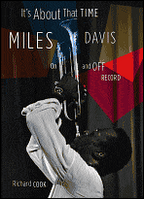 It’s About That Time: Miles Davis On and Off the Record
It’s About That Time: Miles Davis On and Off the RecordBy Richard Cook
Oxford University Press
0-19-532266-5
Discography can tell you quite a bit about an artist. It shows what an artist was doing at a specific time, where they were, and who they were with. Discography as biography describes the approach Richard Cook takes in It’s About That Time, a detailed analysis of classic Miles Davis albums and the circumstances which produced them.
Writing about Davis is a daunting task. In recent years, two books have been devoted to his classic Kind of Blue album alone. Cook tackles his subject without reservation sometimes leveling verdicts that fans of the trumpeter may take issue with. Few albums in the Davis catalog are as revered as Sketches of Spain, one of his most popular collaborations with Gil Evans. Yet in Cook’s judgment, Sketches “does sound like a record where its creators were trying too hard.” (p.125)
In other respects, he offers a more favorable evaluation of some aspects of Davis’ music. For instance, tenor player Hank Mobley has usually received critical short shrift for his work succeeding Coltrane in the Miles Davis quintet. Most argue Trane overshadowed Mobley on Someday My Prince Will Come, a transitional album from Davis, which featured both tenors. Cook however, singles out Mobley’s solo on “Old Folks,” calling it “truly lovely.” (p. 131) He describes Mobley’s style in complimentary terms, asserting:
“the lack of plangency in his tone disguised a clever and very inventive way of particularizing his solos: often he would work against the beat, or use unusual phrase lengths or shapes.” (p. 130)
As for Davis’ late Warner Brothers years, Cook seems expresses some affection for the unfairly overlooked soundtrack to the film Dingo, calling it “curiously enjoyable.” (p. 306) Featuring a score largely composed by Michel Legrand, Dingo co-starred Davis himself as an expatriate American trumpet player, Billy Cross, whose chance performance on a remote Australian runway would have significant impact on a local musician. Cook seems to agree that the movie is underrated as well, writing: “The film, alas, disappeared quickly and was barely given a full release.”
The more dramatic events of Miles Davis life certainly intrude in Cook’s narrative, but he does not dwell on them past their effect on the music. That Time is more concerned with the musical relationships in his career, and it is impressive to review the illustrious sidemen who have come through his group. Cook does offer some interesting what-ifs, such as what if the West Coast based British pianist Victor Feldman had accepted a permanent spot in the band, after their work on Seven Steps to Heaven?
Far from being hagiography, Cook is often a tough critic of Davis’s playing. It would be interesting to know if his opinion of Davis blossomed or shrank as a result of the close listening that went into the book. Regardless, there is a lot of insight into the music of Miles Davis in That Time, and it is also a useful tool in untangling the convoluted mix & match blender of many of the 1970’s Columbia releases. More than anything, Miles Davis fanatics will enjoy it as a jumping off point for debates on the relative critical judgments of an immensely influential artist.